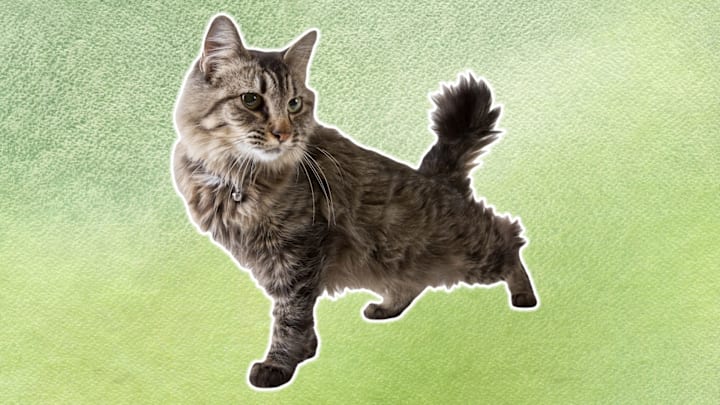We’ve sung the praises of the Manx cat from Wales, and oohed and aahed over the Japanese bobtail. However, we’d be remiss if we didn’t mention that America, too, has its own adorable short-tailed feline. The American bobtail is a large, muscular cat with a “bobbed” tail that stems from a natural genetic mutation. Here are five facts about the kitty’s origin, history, appearance, and personality.
1. The American bobtail is a relatively new breed of cat.
Like most feline breeds, no one quite knows where the American bobtail comes from. According to the Cat Fanciers’ Association (CFA), colonies of short-tailed cats have lived on Spain and Portugal’s islands for hundreds of years. The CFA speculates that sailors adopted the unique kitties, and brought them to the New World during the Age of Exploration—but the jury’s still out on their true home.
Centuries later, cats with short, stubby tails were reportedly bred in America around the mid-20th century. But according to one popular story, the American bobtail breed we recognize today didn’t originate until the 1960s, when a vacationing couple, John and Brenda Sanders, took a shine to a short-tailed brown tabby cat they spotted in Arizona. The tomcat reportedly came from a local Native American reservation. Thanks to his wild appearance, local rumors swirled that the tom was the offspring of a bobcat and a domestic cat. (The second tale turned out to be false.)
The duo adopted the orphaned kitty and named him Yodie. They brought him home to Iowa, where Yodie mated with his owners’ seal point Siamese cat. The union resulted in a litter of kittens, some of which had short tails. This indicated that a dominant gene caused Yodie’s short tail, since the babies only needed one copy of the gene to inherit the trait.
After that, the breed’s evolution is a bit sketchy. According to some, cat fanciers named it the American bobtail in the 1970s, and they set a preliminary breed standard that called for a cat with pointed markings, white mittens, a white facial blaze, blue eyes, and a short tail. They also began outcrossing Yodie’s descendants with other cat types—Ragdolls, Birmans, Himalayans, Siamese, and potentially Manxes, to name a few. But this desired look proved challenging for breeders to replicate.
So in the 1980s, a group of breeders created a new and improved American bobtail from scratch: They used short-tailed feral and domestic cats from around the U.S. (no pedigrees or non-domestic short-tailed breeds allowed!) to create a feline that looked like the breed’s progenitor, Yodie: a large, wild-looking kitty with a bobbed tail.
Over time, breeders developed longhaired and shorthaired versions of the cats. As the bobtail’s pedigree crew, they stopped adding feral cats to the bloodline. Today’s American bobtail comes in a variety of patterns, colors, and fur lengths.
In 2002, The International Cat Association (TICA) fully accepted the American bobtail breed, and in 2000 the CFA approved it for registration. The American bobtail finally received full championship status from the CFA in 2006.
2. The American bobtail is different from the Japanese bobtail and the Manx.
With its short tail, the American bobtail naturally evokes comparisons to felines like the Japanese bobtail or the Manx. However, there are subtle differences between each breed—and while cat lovers believe that the American bobtail may stem from a variation of the Manx gene, neither kitty is related to their Asian counterpart.
The Manx cat’s short tail is caused by an incomplete dominant gene, so kittens in their litters can be born with varying tail lengths, ranging from longer to shorter to no appendage at all. Plus, Manx cats carry one gene for a full tail, and one for taillessness, so when they mate they sometimes give birth to babies that look like your ordinary, run-of-the-mill cat.
In comparison, while American bobtail litters sometimes yield babies with full-length tails, they’re almost never completely tailless. Instead, they’re usually one-third to half the length of a normal tail. The American bobtail is typically healthy—but if it’s born with a too-short tail, it can sometimes have problems controlling its defecation.
3. The American bobtail comes in a variety of colors and patterns.
The American bobtail’s most noticeable feature is its tail. It’s broad at the base, and typically ranges in length from one to four inches. Generally, the appendage is just long enough to be visible above the cat’s back when it stands up. Tails can be curved, kinked, twisted, or nearly straight. No two are exactly alike, and no one type is preferred—although bobtails with a lack of tail, full-length tail, or docked tail are automatically disqualified in cat shows.
As for the rest of its appearance, the American bobtail is a large, muscular cat with a broad, wedged face and long hind legs. Typically, it weighs anywhere from seven to 16 pounds. The breed boasts a variety of eye colors, fur shades, and patterns, but cat show judges often give extra points to American bobtails that resemble their wild-looking ancestors. Bobtails can have dense, short fur or long, slightly shaggy fur [PDF].
4. The American bobtail is a rare (and expensive) breed of cat.
Since major cat fanciers’ associations only recently accepted the American bobtail, it’s still pretty rare. Understandably, because the American bobtail is so scarce, it’s also expensive. Prices range from breeder to breeder, but commonly fall anywhere from several hundred dollars to more than $1000.
5. American bobtails are great companions for people.
American bobtail cats are said to have playful, dog-like personalities. According to some reports, they’re so patient and laid-back that long-haul truckers have used the cats as cabin companions, and psychotherapists have integrated them into their treatment sessions.
A version of this story originally ran in 2016; it has been updated for 2022.
